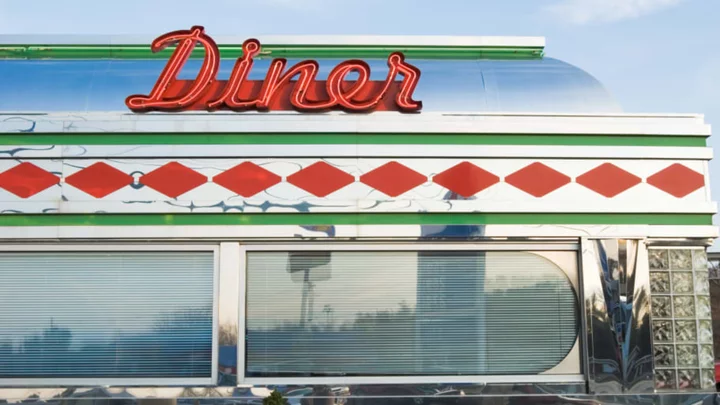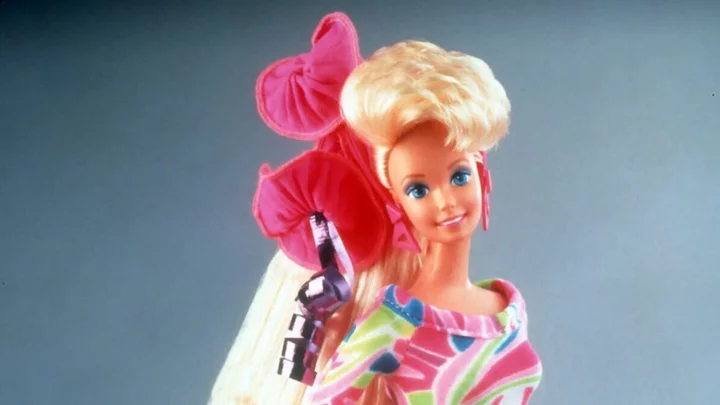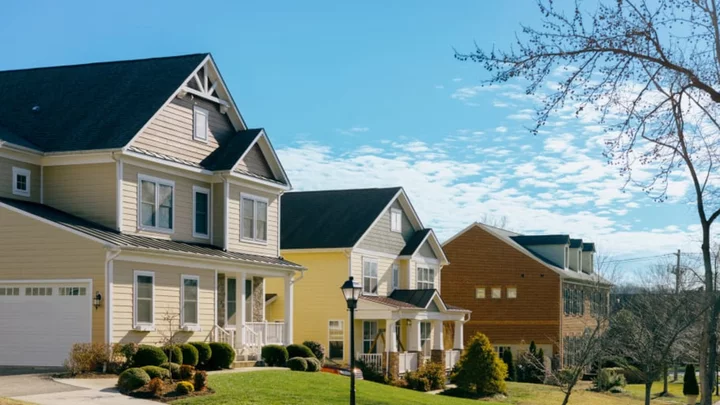From the painting NightHawks to the sitcom Seinfeld, New York City diners are an intrinsic part of American pop culture. If you live in the U.S., you probably have a diner that’s special to you, whether it's a 24-hour spot that you drank coffee and ate French fries in as a teen, or a mom-and-pop shop where your family went for Sunday breakfast (and where you probably always ordered the exact same thing).
But where did these restaurants made of chrome and neon originate? Here’s the history of diner dining, from their Lunch Wagon ancestors to those “We Are Happy to Serve You” take-out cups, adapted from an episode of Food History on YouTube.
Horse-Drawn Beginnings
Diners began as mobile food wagons that would come out at night to serve simple meals to workers on the third shift. They were literal wagons—carts pulled by horses. Although street food vendors have existed as long as cities have, most had simple setups and sold only one kind of food (pies and baked potatoes were popular choices) and they operated during the day.
The first nighttime food wagon, as far as anyone knows, was started by Walter Scott in Providence back in 1872. Scott sold sandwiches, coffee, and pies out of his repurposed, horse-drawn wagon. Scott’s mini-restaurant on wheels was so successful that he quit his day job as a printer.
Soon, many other New England entrepreneurs mimicked Scott’s business model. These businesses were called “Lunch Wagons.” They were essentially late-19th century food trucks: they could pull up to multiple businesses in a day or stay put at one known location. The food was prepared inside over simple stoves or stored in iceboxes and served out a window to customers on the street.
Manufacturers opened up that specifically built or retrofitted the wagons. They were decorated with fancy lettering and murals and had an overhang to keep customers dry or shaded in inclement weather. In 1887, one entrepreneur added inside seating. The Lunch Wagons became “Rolling Restaurants.”
This concept spread quickly with an assist from the temperance movement. If you were a hungry night worker and all that was open was a saloon, that’s where you’d go—but lunch wagons provided a zero-proof option for cheap coffee and a sandwich.
Eventually, these wagons started getting so popular they extended their hours outside of the night trade, which put these lightly taxed operations in competition with normal restaurants for the morning rush. Faced with upset restaurateurs, saloon owners, and people angry with the wagons clogging up increasingly busy streets, cities that had been perfectly fine with nighttime wagons started clamping down on daytime operations.
Wagon owners started parking on private property where they could set their hours without incurring the wrath of local municipalities. Now with more-or-less permanent locations, these night lunch “wagons” started turning into lunch “cars.” Then in the 1920s they’d become known as dining cars, which was eventually shortened to diners.
The seating was often a simple counter with stools, designed so that customers didn’t stay too long. One manufacturer, Jerry O’Mahony, was based in New Jersey and shipped cars to clients all over the country. O’Mahony’s dining cars were pretty much fully stationary. In this way, he’s sometimes credited with inventing the “diner”—a prefabbed restaurant inspired by railroad cars. Other companies would sometimes actually outfit decommissioned railroad cars with a kitchen and indoor seating.
O’Mahony was one of the first diner manufacturers in New Jersey, but not the last. Throughout the 20th century, New Jersey was the leading maker of diners; about 95 percent of all prefab diners were built in the state. Diners were shipped worldwide, and they could even be sent back to the factories for updates and repairs. But many of these buildings stayed local. To this day, New Jersey is known as the Diner Capital of the World, with more than 500 active diners in the state.
But a spot called Casey’s, in Natick, Massachusetts, is America’s oldest continually operating diner. It started out as a lunch wagon in the 1890s. The current structure was built in 1922 by the Worcester Lunch Car Company. It’s been family owned for four generations, and still serves breakfast, lunch, and dinner as well as a tempting assortment of pies.
From the City to the Suburbs
While lunch wagons started in the cities, diners thrived in the suburbs. Post World War II, many white Americans left cities to move to suburbian areas in places like Long Island—and diners literally followed them.
Especially for white men that had served in the military, government programs made buying a home accessible. The idealized “American Dream” made a white picket fence and a yard the ideal. At the same time, “redlining”—housing policies that reinforced segregation—as well as other financial embargoes placed against people of color, forced many families to stay in urban neighborhoods.
Diners were rarely an exception to this divided norm, whether due to Jim Crow laws or de facto segregation that arose from geographical and socioeconomic differences. Think of the diner’s cousin, the lunch counter, and the role sit-ins at them played in the civil rights movement.
What diners were able to bridge, to an extent, was a socioeconomic divide within racially segregated communities. They often occupied a geographic fringe between the city and the suburbs, catering to people in both spaces. The fact that they could serve dishes to factory workers and office professionals, families and solo diners alike, speaks to their wide-ranging appeal. Their prevailing racial segregation, though, hints towards the limitations of food as a uniting force.
Diner Design
Since diners were designed as portable structures, the dining cars were loaded onto trucks and shipped to the ‘burbs—but diners had to evolve once they arrived. They no longer served just rough and tumble male overnight workers; they needed to fit into the family-oriented model of post-World War II America.
The diner’s interiors were redesigned to match the era’s conception of a chic, modern home, including “Formica countertops, porcelain tiles, leather booths, wood paneling, and terrazzo floors,” as Joan Russel wrote for Paste magazine. These were the same materials that appeared in many of the new bungalows of the suburban middle class. The old counters and stools remained, but booths and tables were added for group seating, appealing to families. Many diners still remained open 24 hours a day, though, to serve their original clientele. In time, these spaces became a refuge for teenagers, a gathering place for those too young to go to bars.
The diners of the 1950s were made from silvery, sleek modern metal railroad cars. Some were built as freestanding buildings, but they still had shiny stainless-steel exteriors, neon signs and a space-age appearance. But if we’re getting technical, these would properly be called “coffee shops.” The term diner technically referred to factory-built, prefabbed restaurants from dining cars that were shipped to a location.
In modern America, of course, coffee shop has taken on a different meaning—generally applying to something like a Starbucks—and diner has become the catch-all name for these family-owned, often round-the-clock restaurants.
The Iconic Greek Diner
The American Northeast still has the highest concentration of traditional diners in the country, with 2000 spread out over New England. But it nearly wasn’t to be—in the 1960s, the increasing spread of chain restaurants led to a diner decline. So, what saved it?
If you’ve ever lived in the New York City area, you might remember that at one time, it seemed like every diner was owned by a Greek family. Anarchist poet and Greek-American historian Dan Georgakas theorized that the tradition was born from the kaffenion, a traditional Greek gathering space for men to drink coffee and ouzo—an anise aperitif—while gabbing about the day.
When Greek immigration to New York started picking up at the turn of the 20th century, these coffee shops came as well, opening in Greek neighborhoods. Although there may be a thematic connection between these spaces and the Greek diners of the late 20th century, it was a second wave of immigrants that largely came after 1965 that made Greek-owned New York diners iconic.
Food businesses are traditionally one of the most common ways new immigrants begin to build a life in America. According to WBUR, “the National Restaurant Association found in 2016 that 29 percent of restaurant and hospitality businesses are immigrant owned, compared to just 14 percent of all U.S. businesses.”
A food business doesn’t take a ton of money to start, and doesn’t necessarily require a complete mastery of English to run. The employees are often from the same country, if not the same town, so there’s a cultural community, with shared language, religion, and social traditions. In the case of Greek diners, new immigrants often started in the back washing dishes and worked their way up from busboy to cook to waiter, until they had saved enough money to buy a diner of their own.
Both the menus and the interior design of New York’s Greek diners are instantly recognizable. The menus can be bafflingly long, encompassing dishes as far-ranging as “pancakes to lobster tails, omelets to spaghetti, moussaka to matzoh ball soup, ‘famous’ oversized muffins to duck a l’orange,” as New York Times writer Dena Kleiman noted on the 1991 menu of the Harvest Diner in Westbury, Long Island. One Manhattan diner boasts 220 menu items. “You have to satisfy everyone,” Harvest Diner owner Charles Savva told the Times. If a new menu item appeared in one restaurant, it usually wasn’t long before it appeared in others.
In a continual race to set each diner apart, owners not only added menu items, but lavish interior decorations, like “chandeliers dripping in faux crystal [and] flowing draperies,” according to the Times, as well as Greek statues, fountains and flashing LED light shows. Even the graphic design of these spaces has had a vast cultural impact: The blue and white take-out coffee cups, often printed with “We Are Happy to Serve You,” a Greek-key pattern, and other Hellenic visuals have become so well-known that MOMA Design Stores sells ceramic versions of this classic cup.
Immigration from Greece into New York City peaked in the mid 20th century. In the first decades of the 21st century, Greek diner owners began to retire and sell off their businesses to newer generations of immigrants—people from South Korea, Bangladesh, Central America, and more.
Diners Today
With the rising cost of real estate in the tri-state area, though, some diners are being priced out of existence. Some classic establishments have been torn down for luxury high-rises; others have been displaced by drug store chains or banks. Surviving diners face competition from restaurant franchises.
And those problems existed before the COVID-19 pandemic, which stopped most of us from dining out. More than half of New York City’s diners have closed in the last 25 years; 419 were open in 2019. Jeremiah Moss, author of the blog Vanishing New York, summed up many New Yorkers’ wistful sentiments when he wrote: “It seems the longer you live in New York, the more you love a city that has vanished.”
But many New York City stalwarts stubbornly remain. B&H Dairy, a kosher dairy restaurant in the East Village that opened in 1938, is currently owned by an Egyptian man and a Polish woman, and is staffed by people from all over the world, who wear shirts that boast “Challah, por favor!”
One of the oldest continually operated diners in New York is Nom Wah Tea Parlor, a dim sum shop on Doyers Street that opened in 1920. When you think of diners, your mind might not go straight to dumplings and chicken feet, but this New York institution suggests the expansive culinary traditions that can fit under the ever-evolving “diner” label. Its classic interior hasn’t been significantly updated since the 1960s, and has the tile floor, formica tables and counters, chrome stools and red vinyl booths of a classic diner. It was started by immigrants, offers affordable fare and—even as it has emerged as a destination for tourists—remains enmeshed in its community. In a nod to its New York identity, its Nom Wah Kuai outpost even introduced the baogel back in 2017, combining the beloved bao bun with the equally esteemed bagel.
For New Yorkers, these diners are places of community and sometimes of celebrity—after all, Seinfeld made the facade of Tom’s Restaurant in Morningside Heights famous. They are family-owned businesses and sometimes refuges for found families.
New York City, and the country at large, is ever changing. It’s hard to say if the diner will survive the next transition. So, if you’re lucky enough to have a family-run diner in your city or town, make sure to kick them some business. Start a new pancake tradition; end up there after a long night, just like when you were a teen; or give yourself a break from doing dishes on a Sunday morning at a place where you can order hash browns, chicken fingers, and a martini all from the same comfortable booth. These institutions deserve to see another generation sit at their counters. And don’t forget about the pies.
This piece was adapted from an episode of Food History on YouTube; subscribe to Mental Floss for more fun and fascinating videos.
This article was originally published on www.mentalfloss.com as The Delicious History of the Diner.









